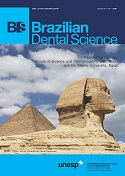Microorganisms related to early childhood caries in a sample of an oral preventive-educative program: a longitudinal study
DOI:
https://doi.org/10.14295/bds.2019.v22i2.1723Abstract
Objetivo: Premature acquisition of cariogenic microorganisms seems to be related to higher prevalence and activity of caries lesions. The aim of the study was to evaluate the prevalence of Streptococcus mutans and Streptococcus sobrinus in infants enrolled in a dental preventive program and in their mothers, as well as to assess the influence of bacterial prevalence, diet and oral hygiene in dental caries prevalence. Material and Methods: After clinical examinations (n = 50), saliva and oral biofilms were collected and stored prior to real-time PCR at 6, 12, 18 and 24 months of age. Results: No correlation was observed between the presence of cariogenic pathogens and diet or hygiene habits at all ages; however, association increased with number of erupted teeth. Salivary levels of bacteria were lower in children than in their mothers at all ages, and children with carious lesions had high ingestion of sugared food. Conclusion: As the levels of cariogenic pathogens were low in the patients that were enrolled in a preventive program, we can conclude that control of oral biofilm as eruption of infants’ teeth occurs and sugar ingestion should be considered of great importance in preventive dentistry, because the association between them was highly positive.
Keywords
Saliva; Dental caries; Oral hygiene; Cariogenic; Streptococcus mutans.
Downloads
Downloads
Additional Files
Published
How to Cite
Issue
Section
License
Brazilian Dental Science uses the Creative Commons (CC-BY 4.0) license, thus preserving the integrity of articles in an open access environment. The journal allows the author to retain publishing rights without restrictions.
=================




























